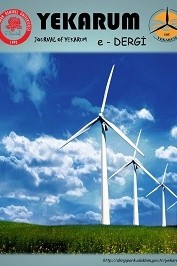MVS 810 Vortex İplik Makinasında Üretilen Farklı İncelikteki İpliklerin Düzgünsüzlük, Hata Ve Tüylülük Değerlerinin Karşılaştırılması
Tüm eğirme sistemlerinde olduğu gibi vorteks iplikçilikte de iplik inceliğinin kütlesel düzgünsüzlük (CVm), ince yer, kalın yer, tüylülük, neps miktarı gibi iplik parametreleri üzerinde etkisi vardır. Vorteks iplikçilikte çok ince ipliklerin üretimi sektör içerisinde de önemli bir sorun olduğundan bu sorunun üstesinden gelebilmek için teorik de halen pek çok bilimsel çalışma devam etmektedir. Ancak vorteks iplikçilikte lif kütlesi direk olarak dönen basınçlı hava akımına maruz kaldığından iplik inceldikçe kesitteki lif sayısının azalmasıyla birlikte yüksek düzgünsüzlük ve tüylülük değerleri karşımıza çıkmaktadır. Bu çalışmanın amacı da 810 Modeli iplik makinesi üzerinde farklı iplik numaralarında üretilen vorteks ipliklerin düzgünsüzlük, hata ve tüylülük değerlerini karşılaştırmaktır.
Anahtar Kelimeler:
Vorteks İplikçilik, MVS 810, Düzgünsüzlük, Tüylülük
Comparison of the Yarn Evenness, Faults and Hairiness Values of Vortex Yarns with Different Yarn Counts Produced By MVS 810
All spinning vortex spinning system as well as in the intricacies of the yarn mass irregularity (CVM), thin places, thick places, hairiness, has an effect on parameters such as the amount of yarn neps. Sector is also a major problem in the production of very fine yarn spinning vortex still remains theoretical in many scientific studies to overcome this problem. However, there appears to be spinning vortices in rotating mass of fibers directly into the compressed air stream is exposed to high evenness and yarn hairiness values decrease with the number of fibers in the thinner sections. The aim of this study on the regularity of the 810 Model vortex yarn spinning machines produced in different yarn counts, to compare the error and hairiness values.
Keywords:
Vortex Yarn, MVS 810, Yarn Evenness, Hairiness,
___
- Anonim. 2000b. No:810 Murata Vortex Spinner. Murata Müşteri Bilgi Kataloğu, 8s.
- Basal, G., Oxenham, W., 2006. Effects of some process parameters on the structure and properties of Vortex spun yarn. Textile Research Journal, 76(6), 492-499.
- Erdumlu, N., Özipek,B., Öztuna, A.S., Çetinkaya, S., 2009. Investigation Of Vortex
- spun yarn properties in comparison with conventional ring and open-end
- rotor spun yarns. Textile Research Journal, 79 (7), 585-595.
- Erdumlu,N., 2011, An approach to investigate the spinnability of fine count yarns on vortex spinning system, PhD thesis, Istanbul Technical University, Istanbul, Turkey, 2011. [5].
- Baldischwieler, O., 2010, Air-jet spinning – yarns & fabrics compared toestablished spinning systems, Proceedings of the XIIth International Izmir Textile & Apparel October 28–30..
- Schwippl,H., Symposium, Izmir,
- Turkey, [6]. Örtlek, H., Ülkü, Ş. 2007. Effect Of Spandex and yarn counts on the properties of elastic Core-spun yarns produced on Murata Vortex Spinner. Textile Research Journal, 77(6), 432-436.
- Örtlek, H., Ülkü, Ş., 2005. Effect of some variables on properties of %100 cotton vortex spun yarn. Textile Research Journal, 75(6), 458-461.
- Örtlek, H.G., 2004. Murata Vortex İplik
- İpliklerin Yapısal Özellikleri ve Bazı Üretim Parametrelerinin Etkileri Üzerine Bir Araştırma. Uludağ Üniversitesi, Fen Bilimleri Enstitüsü, 144, Bursa.
- Üretilen [9].Zou, Z., Liu, S., Zheng, S., Cheng, L., 2010. Numerical computation of a flow field affected by the process parameters of Murata Vortex Spinning. Fibres&Textiles in Eastern Europe, Vol. 18, No 2 (79), pp 35-39.
- Başlangıç: 2010
- Yayıncı: Süleyman Demirel Üniversitesi
